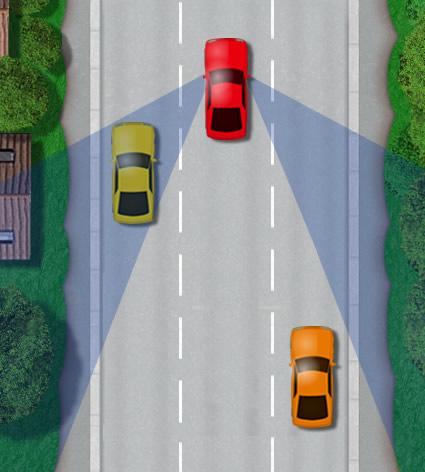Many accidents occur due to drivers failing to check the blind spot. It’s for this reason that driving instructors teach learner drivers where the blind spot is and when to check it.
Although mirrors allow a driver to see a wide angle of observation behind them there are areas that cannot be observed in the mirrors. These blind spot areas can easily hide a cyclist or another vehicle.
A significant proportion of driving tests are failed simply due to the learner not checking the appropriate blind spot at the appropriate time. This section offers an explanation of the car blind spot and when to check it.
Where is the Blind spot while driving
Let’s take a look at the 3 cars in the diagram driving along a motorway. Every car has 2 blind spots each side of the car as suggested by the blue shaded areas coming from the red car in the diagram. The blue shading is the area that the driver of the red car cannot see into simply by looking into the mirrors alone.
The orange car can be seen in the red cars right door mirror and perhaps slightly in the interior mirror. The yellow car is completely out of sight from the driver of the red car as it is in his blind spot.

If the red car driver wants to change over to the left lane where the yellow car is, he will first need to look into his interior mirror, followed by the left door mirror and then briefly look over his left shoulder to check the left blind spot before changing lanes. Failure to check this blind spot could clearly cause an accident. The same procedure must be completed if he wished to move to the right hand lane.
Blind spot before driving off
Driving tests are frequently failed due to forgetting a blind spot check before driving off. It is not essential to check the left blind spot before driving off although the right side blind spot must always be checked by looking over your right shoulder before moving. It is quite possible that a cyclist could be in the right blind spot which would likely lead to serious consequences if you moved off into their path.
When to check the blind spot
Before moving the car off from a stationary position. During a driving test, the examiner will ask a learner driver to park on the left next to a kerb. The driving examiner will often simply ask the learner to move off again when they are ready. This is so that they can check your control and safety before and during moving off. This of course includes you checking the blind spot. Changing lanes whether to the left or right, the appropriate mirrors and blind spot must be checked before moving the car in that direction.
If you live in an area where there are a large proportion of cyclists, the blind spot will need to be checked more often. Cyclists are often unpredictable. Let’s take an example; you are driving down a road and wish to take the next left turn. You take a look into your interior and left mirror and signal to the left.
You have only just overtaken a cyclist. Before making that left turn, you must ensure you look into your left mirror again to locate the cyclist. If you are unsure where the cyclist is, you must look over your left shoulder into the blind spot to see if they are there. If they are, then you must stop the car or slow down significantly to allow the cyclist to pass. Essentially, in any situation where there are cyclists and you wish to change direction, check the blind spot of the direction you are going before proceeding.
Blind spot mirrors
It is possible to use extra mirrors that attach to your existing door mirrors that offer the driver a wider angle of side and rear observation. Even if these mirrors claim to cover blind spots, they must simply be used as an extra observational aid and not to replace physical checks of the blind spot. This is likely to not only lead to a degree of complacency whilst driving, but will ensure you fail the driving test.
A-Pillar Blind Spots
Other blind spots can be found around the car that cause obstructions whilst driving. The A-pillar blind spot contributes to many road casualties each year, often due to a lack of time spent observing. See: